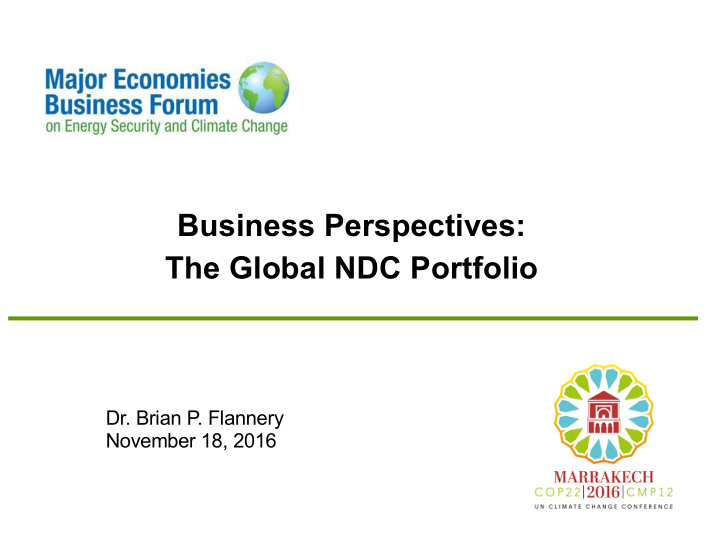



Business Perspectives: The Global NDC Portfolio Dr. Brian P. Flannery November 18, 2016
Business perspectives on INDCs • INDCs: What we know, don’t know • Important to consider economy-wide and global interactions of INDCs • Illustrative study of national and global implications Based on the RITE Integrated Assessment Model (IAM) • Opportunities for business to inform international processes (Transparency, Global Stocktake) Business engagment can inform formal and informal processes to review and renew NDCs (challenges and opportunities to strengthen Paris Agreement) 2
What we know and don’t know about INDCs Many INDCs do not provide clarity on: • Assumptions that underpin the INDC, e.g. population, GDP, productivity growth, availability of technologies and other options… • Policies to implement action • Metrics to evaluate outcomes (if not economy-wide emissions) • Financial (and other) transfers to developing nations Hinders efforts to inform transparency processes on INDCs now, on progress and trends (going forward), and future updates to (I)NDCs Creates challenges and opportunities for: • ex ante projections now • progress, trends and ex post results going forward • discussion of comparability of effort • update of (I)NDCs 3
Economy-wide and global interactions Outcomes cannot be assessed sector by sector, or without considering the global portfolio: feedbacks and interactions are ubiquitous... IAMs provide this capability • IAMs are a fundamental tools used by academics, research institutions and many nations to assess national and global climate policy (central to IPCC WG 3) • Business and governments have supported IAM R&D for decades… and provided input, e.g., on energy outlooks, technology options and representation of climate and energy policies • IAM analyses will play a central role informing in analyses of (I)NDCs and as input to strategic planning by governments, business, academia and think tanks To simulate economic and environmental outcomes resulting from INDCs modelers must “fill in the blanks” and specify assumptions, policies and other technical information missing in proposed national INDCs 4
Comparison of emission reduction ratios (in 2030 from a base year of 2005) Switzerland -51.6 larger Norway -44.5 EU28 -34.8 Canada -30.0 New Zealand -30.0 United States (2025) United States -27.0 Australia -26.0 Japan -25.4 Korea -5.3 Russia 14.2 East Europe (Non-EU countries) Non-EU countries) 15.6 Belarus 19.0 Kazakhstan 19.7 Thailand 30.1 Ukraine 32.2 Mexico 32.8 South Africa 38.2 China 116.9 smaller Turkey 180.9 India 235.4 300 250 200 150 100 50 0 -50 -100 GHG emission compared to base year (2005) (%) NDCs for 20 regions on a common basis from 2005 to 2030 5
Comparison of CO 2 marginal abatement costs Switzerland 380 Japan 378 bigger EU28 210 Canada 166 Korea 144 New Zealand 95 United States (2025) United States 85 Norway 70 East Europe (Non-EU countries) East Europe (Non-EU … 58 Thailand 54 Australia 33 Mexico 27 Kazakhstan 14 Belarus 12 Russia 4 South Africa 1 Turkey 0 India 0 smaller Ukraine 0 China 0 0 50 100 150 200 250 300 350 400 CO 2 marginal abatement cost ($/tCO 2 ) All INDCs implemented with an economy-wide, domestic GHG tax (theoretically the least-cost policy to achieve the pledge) 6
Comparison of retail electricity prices EU28 35.8 Japan 33.9 higher Switzerland 27.7 Australia 24.2 New Zealand 23.5 Turkey 15.9 United States (2025) United States 15.9 East Europe (Non-EU countries) East Europe (Non-EU … 15 Thailand 13.5 Belarus 12.3 Mexico 11.4 Canada 11.0 China 10.5 Norway 8.6 Kazakhstan 8.4 South Africa 7.7 Korea 5.6 Ukraine 5.4 lower India 5.2 Russia 1.8 0 5 10 15 20 25 30 35 40 Electricity (household) price ( UScent/kWh ) 7
GHG emissions of the aggregated INDCs & pathways to 2100 toward 2 ° C goal 200 About 6$/tCO 2 in 2030 under the least About 70$/tCO 2 in 2050 even GHG emissions (GtCO 2 -eq./yr) cost measures to achieve the expected global under the least cost measures emission reductions by INDCs 150 Baseline emissions reported in the IPCC AR5 100 50 around +2.5 to 3 ºC About 320$/tCO 2 in 2050 even around +2 to 2.5 º C under the least cost measures below +2 ºC 0 1990 2000 2010 2020 2030 2040 2050 2060 2070 2080 2090 2100 Historical emissions Source: Estimate by RITE Emission outlook under current policies +2.5 ºC stabilization under climate sensitivity of 2.5 ºC (around +2.6 ºC in 2100 and +3.0 ºC in 2200 under C.S. of 3.0 ºC ) +2 ºC stabilization under climate sensitivity of 2.5 ºC; temporary overshoot of 580 ppm (+2.5 ºC stabilization under C.S. of 3.0 ºC) Below +2 ºC in 2100 under climate sensitivity of 3.0 ºC; temporary overshoot of 530 ppm +2 ºC stabilization under climate sensitivity of 3.0 ºC; temporary overshoot of 500 ppm and around 450 ppm in 2300 INDC submitted by October 1 (119 countries) assumed to be implemented 8
Insights from IAMs… Ex ante assessment: assumptions, policies, anticipated outcomes • Understanding of the INDC • Comparability of national efforts • Implications for competitiveness: investment, trade • Need to account for economy-wide interactions: across sectors, supply and value chains • Need to account for global interactions trade, investment, wealth transfers Ex post review to inform future pledges • Validity of assumptions • Effectiveness of policies • Consequences of unforeseen (not in the plan) developments natural events, recessions, technology change Business perspectives can make key contributions to inform domestic and global assessments 9
Going forward the Major Economies Business Forum… Intends to organize and contribute to workshops and other efforts to help understand both domestic and international progress under the Paris Agreement Will engage business, governments, the UNFCCC, academic and research institutions in dialogue to complement formal “transparency processes” to assess NDCs and take stock of collective action under the Paris Agreement 10
Thank You Dr. Brian P. Flannery www.bizmef.org bpflann@gmail.com
Recommend
More recommend